
May 27, 2022 Ryukyu Shimpo
By Shugo Asato, Wakana Aragaki
High levels of PFAS (organofluorine compounds), which are known to be harmful to the human body, were found in tap water at the Chatan water treatment plant in Okinawa Prefecture. In response, a coordinating committee devised to protect citizens from PFAS will independently investigate the blood PFAS levels among locals starting in late June, in collaboration with Kyoto University. The target population size is approximately 350 and will reside in six selected municipalities in seven areas. The committee hopes the research will spawn sweeping public health studies by the national, prefectural, and municipal governments.
PFAS is not easily broken down and accumulates in the human body. It has been detected at high levels in rivers and groundwaters, especially near U.S. military bases. The independent research will investigate the accumulation of PFAS (namely PFOS, PFOA, and PFHxS) among local subjects and any relationship to human health conditions.
The areas in scope are Chatan, which is supplied with tap water from the Chatan water treatment plant; Nagata and Kiyuna in Ginowan City, where the Futenma Air Station is located; and parts of Okinawa City. Kin, where high levels of PFAS were found in its tap water, and Kadena, where Kadena Air Base is located, are also within the scope. To establish a baseline, the research will also include Ogimi Village, where there are no U.S. military bases or previous findings of PFAS.
The investigation costs will not fall on the residents of the communities in scope but will be funded by the PFAS Health and Environmental Survey Fund, a donation collected by the coordinating committee at prefectural assemblies. The committee will be requesting doctors and healthcare providers to travel to the target neighborhoods and collect blood samples. The sample analyses will be conducted and funded as part of a separate study led by Associate Professor of environmental health at Kyoto University Koji Harada’s epidemiological study pertaining to metabolic disease risk in areas with high exposure to the persistent organic pollutant PFAS.
Sample collection is scheduled to conclude by early August and will take approximately two months to analyze.
For inquiries, contact Toshio Takahashi, secretary-general of the coordinating committee at: 090 (1088) 3007.
(English translation by T&CT and Monica Shingaki)
Go to Japanese
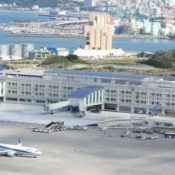
May 27, 2022 Ryukyu Shimpo
By Yosuke Anri
Prime Minister Fumio Kishida announced on May 26 that Naha Airport’s international travel routes, which have been suspended in full since March of 2020, would reopen sometime in mid-June. As part of the easing of border control measures implemented during the COVID-19 pandemic, the Ministry of Health, Labour and Welfare is adding Naha and New Chitose Airports to the existing list of five airports such as Haneda that meet the requirements for quarantining and are allowed to have international flights arrive and depart from their runways.
The airport will be allowed to accept foreign visitors to Japan starting June 10. In order to prevent the spread of the coronavirus, for the time being entry will be restricted to visitors partaking on guided tours, for which it is easier to keep track of visitors’ itineraries.
Japan’s central government will double the number of daily allowed foreign visitor entry from 10,000 to 20,000 people, and will reclassify quarantine measures for visitors, including Japanese citizens returning to Japan, coming from “blue-level” countries, considered low-risk for infection, as being exempt from testing and self-isolation when entering the country.
As of May 26, the countries on the list of “blue” low-risk countries include 98 countries and regions including the US, China, and Korea. The list will continue to be reevaluated as needed. The foreign tourist visitors coming from “blue” countries will be counted against the 20,000 foreign-visitor limit. There will be no limit placed on the number of people who can join a guided tour, or for domestic travel.
If hosts follow the procedures of their given regions, the country will also allow for both short term (under 3 months) and long-term entry for foreigner for the purpose of business and employment.
Kishida said in a speech in Tokyo on May 26 that, “Our goal it to gradually increase the number of allowed visitors,” and that their policy will continue to expand while keeping a close eye on case levels.
Prior to lifting the ban, the Ministry of Land, Infrastructure, Transport and Tourism (MLIT) have been inviting representatives from tourism companies from four countries including the U.S. for demo tours since May 24. The goal was to establish transmission prevention practices and communication lines for when a visitor tests positive. They are also compiling similar guidelines for the business community as well.
It has been two years since the start of the foreign tourist ban. In 2018, there were over 30 million visitors to Japan, 3 million of which came to Okinawa (of which 1.8 million came by air). However, due to the coronavirus pandemic Naha Airport suspended all international flights starting in March of 2020, and there were zero foreign tourists that came to Okinawa over the two-year period of 2020 and 2021, delivering a massive blow to the Okinawa economy.
(English translation by T&CT and Sam Grieb)
Go to Japanese
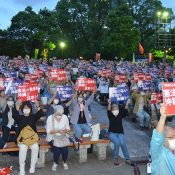
May 27, 2022 Ryukyu Shimpo
By Manato Akira
A rally called “construction of a new base in Henoko is not permitted and Okinawa and Japan are covered by the constitution, in Tokyo”, opposing the construction of the Futenma Replacement Facility (FRF) in Henoko, Nago City, was held at the Hibiya Open-Air Concert Hall in Tokyo on May 26 following the 50th anniversary of Okinawa being returned to Japanese sovereignty. About 1,000 people participated, and raised their voices to say “Protect the constitution”, “Stop building the new base in Henoko”, and the like. After the rally, the participants marched through the city.
Kazuhiro Katsushima, the person in charge of the Okinawa Project “Don’t Allow War, Don’t Destroy Article 9! Collective Action Committee” which hosted the rally, voiced the sense of crisis he feels by saying: “The return of Okinawa lacked any viewpoint for the protection of human rights. As fortification progresses, Okinawa is being used as a sacrifice stone by the mainland and America.” (Translator’s note: The term “sacrifice stone” relates the game go, and refers to a stone that a player allows to be captured by the opponent.)
Genpei Ishikawa is the former head of the Okinawa Teachers Union, and worked as a secretary for Chobyo Yara, the first publicly elected chief executive of the Government of the Ryukyu Islands. In a video message, Ishikawa explained that, “Through the tragedies of the Battle of Okinawa, the purely Okinawan pacificistic concepts of ‘life is a treasure’ and ‘life itself is a treasure’ were attained”, and he also gave an introduction about the peace movement before and after Okinawa’s return. In his later years, Chobyo Yara repeatedly voiced his contrite feelings that: “Okinawa must not suffer through being sacrificed at the hands of state authorities a second time.”
At the rally, National Diet members belonging to the Constitutional Democratic Party, Communist Party, Social Democratic Party, and the House of Councillors faction called Okinawa Whirlwind also took the podium.
(English translation by T&CT and Erin Jones)
Go to Japanese
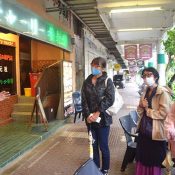
May 23, 2022 Ryukyu Shimpo
By Ryota Shimabukuro
Okinawa City – The Okinawa Multicultural Society Promotion Association (run by Okinawa City) restarted their walking tours through the history of Koza on May 2 after a three-year hiatus. The tours had been paused for that time due to COVID-19. Takahiro Kina, 57, where he showed the post-war history, culture and cuisine in front of the gates of the largest air base in the far east, the U.S. military’s Kadena Air Base.
There were nine people on the tour, where they could view from the top of a building the expansive Kadena, the spacious homes of U.S. military personnel around base, and the tightly packed buildings of the Okinawan residential area.
Kina explained that during the Vietnam War, many of the US soldiers deployed to the battlefield from Koza. He explained that businesses in the area saw great profits from soldiers who spent extravagantly as they prepared themselves to face death in battle, but that the area was also plagued by a never-ending string of incidents as well.
The tour also enjoyed some local food at the long-standing “Ocean” taco stand, which was a location for the filming of the movie “Miracle City Koza.”
For inquiries, contact the promotion association at 098 (989) 9392.
(English translation by T&CT and Sam Grieb)
Go to Japanese
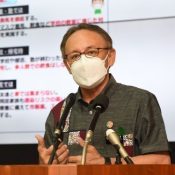
May 20, 2022 Ryukyu Shimpo
By Shohei Tsukazaki
On May 19, the Okinawa prefectural government’s Covid-19 task force gathered and announced that the Covid alert issued on Okinawa’s main island and Miyako Island will remain in effect through May 26.
Following the task force meeting the same day, Governor Denny Tamaki held a press conference to explain that local schools are straining to provide PCR tests and he is considering distributing antigen test kits, which can swiftly produce results.
The governor also said he will scale back the June 23 Okinawa Memorial Day service for the third year in a row.
Okinawa’s Covid cases at a glance
Furthermore, the prefectural government announced the same day that 2,307 people ranging in age from under 10 to over 90, have been newly infected with a new strain of the coronavirus.
Governor Tamaki cited the continued rise of Covid cases among children under 10 years old and conveyed his skepticism of the current national countermeasures: “There is evidence that [the current] Covid prevention efforts focused on restaurant [restrictions] are ineffective.”
The governor said hospitalization rates “have remained high since the [May] holidays,” and cautioned against overwhelming the healthcare system.
Tamaki further called for voluntary restraint in visiting hospitals for Covid testing and thorough Covid prevention measures in schools.
As for the Memorial Day service for the war dead, he said, “We are determining the appropriate number of guests for preventing infections.”
The governor did not, however, specify when antigen tests will be rolled out to schools, but only stated that it will happen “as soon as possible.”
Toru Itokazu, the Okinawa Prefectural Government deputy director-general in charge of health and sanitation, spoke on Covid infections in local schools and stated that requests for PCR testing at schools surpassed 100 per day. The requests come from other schools, students, and daycare centers, and Itokazu asserts that the Covid-19 virus is carried into schools by those who have been infected at home.
(English translation by T&CT and Monica Shingaki)
Go to Japanese
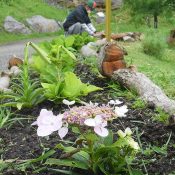
May 20, 2022 Ryukyu Shimpo
By Kenta Masuda
Nakijin – The “Miracle Hydrangeas” planted at Nakijin Castle Ruins, which were distributed throughout Japan as a symbol of recovery from the 2011 Tohoku earthquake and tsunami, bloomed for the first time at the end of April. The flowers were originally planted three years ago, and through cutting the number of stocks increased from three to fourteen. The light-pink flowers now decorate the castle ruins’ grounds.
The Miracle Hydrangeas were found at the bottom of the reservoir after the Fujinuma Dam in Fukushima broke during the disaster, and the plant was divided for distribution all over Japan by the Naganuma Society of Commerce and Industry. The flower made its way to Nakijin Castle Ruins via Urasoe City and were planted in June of 2019. It was planted carefully after selecting soil that would retain water. It bloomed just before the start of the rainy season, and a number of additional buds have been found throughout the month as well. It also looks like there will be some flowers tinged with a bit of blue.
Kenta Harada, 46, from the Nakijin Village Gusuku Information Center said, “We took care of the flowers along with all the other plants while seeing how it would work with the Okinawa environment, and it finally bloomed. We want to make the castle ruins a place that is filled with flowers. We want to add some nature to the history and culture [of the ruins].” He is calling for local residents and tourists to come visit.
The Miracle Hydrangeas have been planted along the walkway from the parking lot to the building that houses the shop and ticket window. They can be seen modestly blooming alongside some Easter lilies with butterflies dancing around. While the cherry blossoms still remain the main attraction, Harada and the store staff want to increase the number of flowers as a feature.
(English translation by T&CT and Sam Grieb)
Go to Japanese
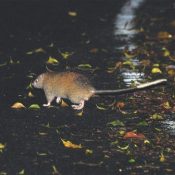
May 20, 2022 Ryukyu Shimpo
By Shugo Asato
Since the beginning of 2022, the occurrences of vehicles running over Ryukyu long-tailed giant rat (Diplothrix legata) has rapidly increased. The Ryukyu long-tailed giant rat is a nationally designated natural monument and an endangered species. The Yambaru Nature Conservation Office of the Ministry of the Environment (MOE) confirmed 10 incidents accounting for the death of 10 of these rats as of May 18. Since October 2021, which was an active breeding time for the rats, the Conservation Office has confirmed 17 incidents accounting for the death of 17 of these rats.
The Conservation Office is calling for drivers to avoid accidentally killing the Ryukyu long-tailed giant rats. A spokesperson for the Office said, “It’s possible that we could save [the rats] if [drivers] limited their speed and quickly reported an incident even after it has already occurred.”
Three Okinawa rails being cared for by the Okinawa Zoo and Museum for “distributed breeding”
The Ryukyu long-tailed giant rat is the largest species of rat in Japan, the adults having a body length of 20-30 cm and a tail length of 25-35 cm. The end of their tails being white is a characteristic of these rats. These rats are nocturnal and are an endangered species belonging to one genus, this species being endemic to and inhabiting only the World Natural Heritage Sites of the Northern part of Okinawa Island, and Amami-Oshima and Tokunoshima in Kagoshima Prefecture.
According to roadkill information publicized by the Nature Conservation Office, the number of incidents involving these rats between 2011 and 2021 was 92 (90 rats killed, 2 rats injured).
The year involving the most incidents was 2011 with 25 incidents (24 rats killed, 1 rat injured). No year thereafter involved more than 15 incidents.
The location where most of these incidents occurred is prefectural road 2 crossing east to west through the woods inhabited by the Ryukyu long-tailed giant rats. 70 of the incidents took place on this road, accounting for nearly 70 percent of the incidents.
The MOE, the Okinawa Prefectural Government, and the “Yambaru Nature Experience Activity Council”, which was established by Kunigami Village, Ogimi Village, and Higashi Village, have made magnetic stickers calling for roadkill prevention for the Ryukyu long-tailed giant rat. These magnetic stickers are being sold for 400 yen apiece, and the money is being set aside for nature conservation activities and the like, including roadkill prevention.
To report an incident or request assistance, call: MOE Yambaru Wildlife Conservation Center at (telephone) 0980 (50) 1025 (8:30 a.m. to 5:15 p.m.) or at (telephone) 090 (6862) 9170 (24-hour); or NPO Animal Hospital Okinawa at (telephone) 090 (6857) 8917 (24-hour).
(English translation by T&CT and Erin Jones)
Go to Japanese
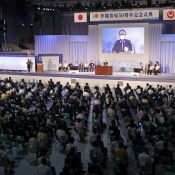
May 16, 2022 Ryukyu Shimpo
By Teppei Ikeda
On May 15, which marks the 50th anniversary of when Okinawa was reverted to Japanese control in 1972, Okinawa Prefecture and the central Japanese government co-hosted the “50th Anniversary of the Okinawa Reversion Ceremony,” at both the Okinawa Convention Center in Ginowan and the Grand Prince Hotel New Takanawa in Tokyo, connected over broadcast. In his ceremonial address, prime minister Fumio Kishida expressed a desire to, “put their full effort into reducing the base burden in Okinawa.” Okinawa governor Denny Tamaki commented in his address, “I want all Okinawans to work together to realize a peaceful and abundant Okinawa where we can feel truly happy.” Neither the prime minister nor the governor directly referenced the closure of MCAS Futenma or the new base facilities being constructed in Henoko to serve as its replacement.
The ceremony was attended online by Emperor Naruhito and Empress Masako, and the emperor commented, “I pray from my heart that a prosperous future can be built in Okinawa,” in his address. There were also greeting the other heads of each of the three branches of Japanese government; the heads of both houses of the Diet as well as from the Chief Justice of Japan, as well as from Rahm Emanuel, the U.S. ambassador to Japan. There were 516 people in attendance in Tokyo and 781 in Okinawa for a total of 1,297 people.
After the ceremony concluded, Kishida met with the press, where he reaffirmed that the Henoko relocation was the “only solution” to removing the danger of MCAS Futenma while maintaining the deterrence of the Japan-U.S. alliance. In response to Okinawa’s demand that the Japan-U.S. Status of Forces Agreement (SOFA) be fundamentally revised, the prime minister commented, “Finding a suitable solution for problems and issues one at a time is fundamental to governance,” and that he felt now was not the right time to revise the agreement.
Governor Tamaki was asked by the press after the ceremony about not stating his opposition to the Henoko relocation during his address, to which he explained, “In the written proposal I handed to the prime minister, Henoko and Futenma are included. In the ceremony itself, I called for the “cooperation and realization of the main points of the proposal.” For this ceremony he commented, “There was a very strong sentiment for the ceremony to look towards the future.”
(English translation by T&CT and Sam Grieb)
Go to Japanese
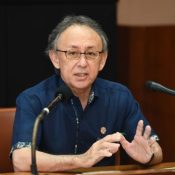
May 10, 2022 Ryukyu Shimpo
By Masakazu Umeda
On May 9, Governor Denny Tamaki gave a joint media interview at the Okinawa Prefectural Office to commemorate the 50th anniversary of Okinawa’s reversion to Japan. He remarked that while Okinawa accounts for 0.6% of the country’s total land area, 70.3% of USFJ facilities and areas (for exclusive use) are concentrated in Okinawa.
The governor stressed that, “at the time of the reversion, the people of Okinawa expected [the military presence] would moderate to levels on par with the main islands of Japan, but the current situation is far from it.”
On the other hand, Governor Tamaki applauded the prefecture’s advancement in infrastructure: “There have been no water outages in decades, and [in some metrics] we are now above the national level.” However, he pointed out that the per capita income continues to be the lowest in Japan: “We are only halfway to realizing the self-reliant economy Okinawans are hoping for.” As for the lack of progress on reorganizing and downsizing Okinawa’s U.S. military bases, Governor Tamaki pointed to the current design in which Washington and Tokyo are the sole decision makers and added, “local governments hosting the bases need to be heard.”
The governor conveyed the prefecture’s commitment to preserving the historical significance of Okinawa’s reversion to Japan: “[The reversion history] is a part of the Uchinanchu pride, which our forefathers protected for their children and grandchildren through the autonomy and reversion movements.”
Tamaki also addressed the growing public appetite to strengthen Japan’s defense capabilities in the wake of the Russian invasion of Ukraine and voiced his concern: “Force has been utilized to change the status quo. Employing more force to counter [it] may trigger an unexpected clash. We must absolutely avoid a scenario in which Okinawa becomes a target or any action that will increase such risk.”
(English translation by T&CT and Monica Shingaki)
Go to Japanese
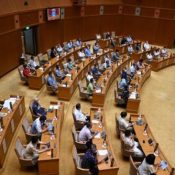
May 13, 2022 Ryukyu Shimpo
On the morning of May 13, the Okinawa Prefectural Assembly held a special session and unanimously approved a proposed written opinion and resolution related to the 50th anniversary of Okinawa’s reversion to Japan. The written opinion coincides with the anniversary and serves as a statement of the assembly’s intent to “address the challenges facing the prefecture in order to create a truly peaceful and prosperous Okinawa.” Assembly President Noboru Akamine and representatives of the ruling and opposition parties will present the document to Prime Minister Fumio Kishida during his visit to Okinawa on May 14.
The written opinion points out the many challenges that remain, even after reversion, to be overcome in Okinawa. These include the average income being approximately 70% of the national average, child poverty, and moving away from a dependent economy. The document states, “Holding fast to our decision to never again engage in war, we will build a strong economy founded on the principles of economic independence. In this way, we will make Okinawa a prefecture in which residents live truly prosperous lives.” Pointing out that close to half of written opinions and resolutions voted on in the Okinawa Prefectural Assembly are related to U.S. bases, the document declares “We reaffirm that we will work unrelentingly to develop our community and to reduce the burden placed on Okinawa by the U.S. bases, including preventing incidents and accidents caused by the presence of the U.S. military.”
In addition, the document calls for the Japanese government to close and return Air Station Futenma to Okinawa as soon as possible, to significantly consolidate and scale down facilities for U.S. servicemembers, and to fundamentally revise the U.S.-Japan Status of Forces Agreement. The document also calls for economic development with an eye to utilizing the restituted land from the U.S. bases, and the creation of new industries that will contribute to the growth of Japan as an oceanic state.
According to the office of the Prefectural Assembly, this is the first time that the assembly has created a statement of intent marking Okinawa’s reversion. This written opinion is addressed to the entire Japanese cabinet, including the prime minister, and to the leaders of the upper and lower houses of the National Diet.
(English translation by T&CT and Ellen Huntley)
Go to Japanese

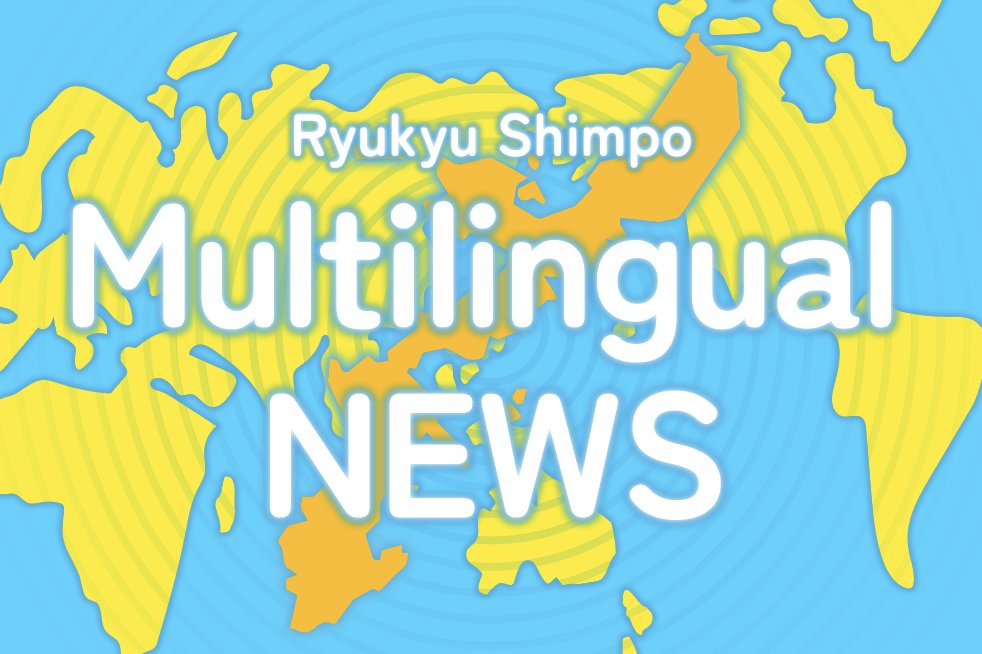









 Webcam(Kokusai Street)
Webcam(Kokusai Street)


